
Management Consultant Leadership
Expert leadership in Beauty Fashion Business Management considers key drivers to position a company for success. Indeed, it’s all about Business Intelligence (BI). First, Innovation which is the desire to move into future advances – including Sustainability practices. Second, Data Analysis where we find the most effective use of it for the business. And third, Productivity and efficiencies in operations. With this in mind, CSC studies the status of the business and its ecosystem. Furthermore, we focus on how to meet the changing demands of consumers, production, and supply networks. Certainly (and most importantly), we are passionate about Beauty Fashion Business Management. Accordingly, CSC leverages decades of BI with major-brand clients and leads in business plan initiatives.
Beauty Fashion Business Management – BI and More
Meanwhile, peripheral drivers that impact all our Industries are taken into account. Recently, we consider the affect of the pandemic. Understandably, we know consumers responded by shifting to value, buying online – among other factors. In addition, they demonstrated behavior as breaking longtime loyalties. Consequently, they looked for new brands that meet new priorities. For this reason, CSC honed in on the opportunity to respond to this consumer-driven environment. First, we took a broad view of the core business and supply chain. Then, we found strategic ways to help reduce cost. Indeed, it provided an opportunity to negotiate supplier terms.
CSC led various projects that maximized BI within Beauty and Fashion and continued to transform and position for efficiency and profitability. In summary, we analyze information and determine advantages before transforming. Whether it is a specific customer experience or operational process. From brand, product, pricing, store concept, and store execution to ideal innovation, digitization and distribution.
Transform, Digitize and Monetize
Surely, we understand the opportunity to allocate resources and objectives for digital solutions. Incrementally, Beauty Fashion Business Management determines ideal adjusting. On the positive side, studies prove the digitizing of processes is delivering successful results. However, important considerations need to be very clear. First, selecting technology solutions is important. Furthermore, attention to the human talent and their adjustment is equally critical. Again – as a BI drive – Innovation requires careful analysis and integration. For this, we consider merging technologies with human creativity to ensure that talent continues to drive Innovation.
Sustainability and Circular Economy
Historically, Beauty and Fashion are Industries that have big challenges with Sustainability and Circular Economy best practices. As these consistently find themselves at the top of the worst to impact the environment, solutions are crucial. From dye, chemical and product manufacturing to packaging, distribution, utilization and disposing. Indeed, a great level of attention and advances are required. That said, Beauty Fashion Business Management best practices have been ramped up in recent years. Certainly, BI and consideration for Guiding Principle goals set the tone. And they have started to transform for the better.
Studies aimed to identify drivers and moderators of Sustainable Fashion Consumption (SFC) have increased. For instance, systematic reviews conducted in recent years determine growth patterns in SFC themes. Regardless, of the exploitation or “buzz words” spins for commercialization. Ultimately, the results indicate that the scope of SFC is expanding. As a result, best practices has expanded from product-based to include larger considerations. From a marketing standpoint, consumer values, consumer knowledge, normative influences, and fashion orientation emerged as four major frequently researched themes in SFC research. Meanwhile, challenges such margins and profitability, lack of understanding of cross-cultural differences and several other related to SFC must be studies further.
BI and Guiding Principles
Industry leaders such as Vogue Business are taking the subject at hand seriously. From physical retail latest sustainable practices to questions on today’s reality in haute couture. For example, studies explores the framing, dominant frame, story focus, and tone of sustainable fashion coverage. As we know, scholars still suggest the fashion industry is currently one of the most polluting systems in the world. In actuality, only 1% of clothing is reportedly being made ethically. Yet, scholars also suggest there is an attitude-behavior gap whereby consumers’ awareness of environmental issues does not change their buyer behavior. Nevertheless, coverage vs. the spin must be analyzed to ensure BI is leveraged at its full potential.
Indeed, the communication angle sparks researcher’s interest in analyzing how fashion publications frame their sustainable fashion coverage. Understandably, suggestions such as how Vogue frames their sustainable fashion coverage are important. Additionally, studies determine how fashion magazines cover fashion sustainability, while offering practical implications to fashion journalists, and theoretical implications to future scholars.
Again, with language like “circular” and “climate-positive” swirling around the best sustainable beauty and fashion brands, we must understand the facts. For instance Chanel’s – just-launched eco-responsible N°1 De Chanel Revitalizing Cream – is a great example. It is made from 95% natural ingredients. New bio-based packaging is clearly marked for each component. To illustrate further, it includes a refillable container made of glass and a cap that includes biocomposite from Camellia husks and wood by-products. In summary, taking the latest industry best practices in combination with BI and leadership, CSC aims for the development of optimum solutions for success.